One of my favorite things to show someone new to the marine environment is the beautiful crown of a feather duster worm. This “flower,” I explain, is the crown of a worm that lives in a tube, and it is both a feeding apparatus and a breathing gill. Next I ask the observer to slowly try to touch the crown. The instant disappearance of it as the worm reflexively withdraws into its tube always leaves a great impression!
I can observe numerous varieties of these creatures along the shore of Biscayne Bay here in Miami, and I have also kept many varieties of them in my reef aquariums. Some of them reproduce, some thrive, others are more delicate and just survive for extended periods of up to two years. This article covers the genera most often seen in aquaria.
The Structure Of The Crown
The crown of feather duster worms is composed of a series of feather-shaped rays called radioles. The radioles are arranged in two half circles that form a funnel shape in many species. In some they form a horseshoe shape or one or two spirals. Cilia on the radioles generate currents that draw water upward into and out of the crown, and they also move particles trapped on the radioles into a groove that conducts the food particles down to the base of the radiole where they are sorted. More on that in a moment.
Water Movement
While some species are capable of living in quiet waters (for example, behind live rock) because of the effective pumping by the cilia, in most species the movement of water through the crown is assisted by water currents in the environment. These species occur only where they typically receive moderately strong laminar water currents. Others, such as the Serpulids with christmas- tree-shaped crowns, tolerate turbulent and multidirectional flows and waves, in addition to laminar currents.
Feeding
The sorting of trapped particles in the crown begins in the conducting grooves on the radioles and finishes at the base of the crown. Large particles ride high on the conducting grooves and they are rejected and emitted up into the current stream at the base. Medium sized particles pass along the center of the conducting grooves and are moved to storage areas where they are subsequently used in the construction of the tube in soft tube species. Fine particles are moved by cilia along the lower portion of the conducting groove into tracts that lead into the mouth. The food includes bacteria, fine detritus and other particulate organic matter, phytoplankton, and tiny microorganisms.
Taxonomy
Feather duster worms are members of the Phylum annelida, the segmented worms, which includes the common earthworm. The feather dusters belong to the class Polychaeta, one of the four classes of annelids. The Polychaetes (literally “many hairs”) have segmented bodies, and each segment bears two or more appendages called parapodia. The appendages are often hair-like, hence the name bristle worms for many varieties of polychaets. In feather duster worms the hair-like chaetae are much reduced. The feather duster worms belong to several families and subfamilies of Polychaeta. Those with soft tubes consisting of a polysaccharide matrix and trapped detritus are in the family Sabellidae, which has only one genus with an exceptional calcareous tube. Most “hard-tube” feather dusters belong to the family Serpulidae, and many members of this family have an operculum that is formed from a modified radiole in their crown. The operculum is a “trap door” that shuts the entrance to the tube when the worm withdraws. The ornamentation of the operculum is used for identification of some species.
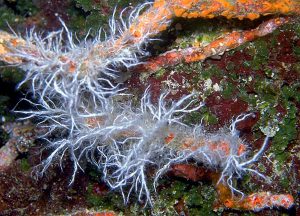
This species of Salmacisphotographed under a ledge in the Solomon Islands has tiny white branchial crowns. Other Species have red crowns, like most Filogranellaspp.
Reproduction
Feather duster worms reproduce both sexually and asexually. Sexual reproduction involves the release of gametes into the water where the fertilized eggs develop into free-swimming larvae that eventually settle in an appropriate habitat. In the case of Serpulids, they settle on corals and the coral grows around the calcareous tube they build, making asexual reproduction nearly an impossibility for them. Soft tube varieties reproduce sexually, but many form dense colonies of clones by a budding process called scissipary. In this process the posterior end of the worm breaks off and develops a new crown while the “parent” grows a new posterior.
Shedding The Crown
Many varieties of feather dusters periodically shed their crown, leaving the novice aquarist horrified and believing the precious creature has died. Don’t remove the tube! The feather duster will re-grow its crown in a matter of weeks. Sometimes shedding of the crown is an indication of starvation or that something about the environment is irritating. If the occurrence is infrequent, it is nothing to worry about. If it occurs every couple of months, there may be an aggravating factor.
Escaping The Tube
Sometimes Sabellastarte spp. leave their tube. This exposes the worm, making it vulnerable to predators. In general it is best not to try to re-insert the worm into its tube. One is more likely to injure it this way, and it is likely that it left the tube for a good reason. Usually they move this way to a better position, in a stronger current. The worm can build a new transparent tube in a matter of hours, and it will coat the tube with sand and detritus over a matter of a few days.
Following is a review of the common varieties that are kept in aquaria, noting important husbandry considerations and comments regarding hardiness.
Bispira
The genus Bispiracontains some common and popular species imported for the aquarium trade, and it also contains some species that reproduce prolifically in aquaria, being introduced with live rock. Not all Bispiraspp. reproduce prolifically, however, and one species, the common “cluster duster,” Bispira brunnea, rarely survives in aquaria. With a little trick, however, one can change its captive fate, as I’ll shortly explain.
Bispira violais the most common species in aquaria. It seems to be ubiquitous- by definition it can be found in most reef aquariums around the world. It is possible that many species exist with essentially the same appearance, but it is equally possible that a single prolific species is widespread in both temperate and tropical oceans. Bispira variegatafrom the Caribbean has essentially the same appearance, but it grows larger and tends to burrow in sand while B. violais common up high on rocks and on algae. Bispira tricycliais superficially identical to B. variegata, and lives in the same habitat, but in the Indo-Pacific region. Both are occasionally harvested for aquariums, and they are long-lived. They reproduce in aquariums by fission, but much more slowly than B. viola. Bispira guinensisis one of my favorite species. It forms a spiral crown when fully developed. Newly formed crowns are funnel shaped and essentially identical in appearance to Bispira tricycliaand B. variegata.
Bispira brunnea, the cluster duster, superficially resembles other member of this genus, but it has a habit so different that I personally believe it should be placed in a separate genus. It forms clusters of clones attached to a hard substrate at a central point. The tubes do not migrate and proliferate onto adjacent substrate like other members of the genus, but develop parallel to one another forming a larger ball of straight tubes. Asexual reproduction thus does not spread the species; it simply increases the colony size. This species is harvested for aquariums from Haiti and the Dominican republic. It is extremely common throughout the Caribbean, including the Bahamas, but mysteriously does not occur in Florida. The harvested specimens have been removed from the rock, something easy to do since they are loosely attached. They do not readily reattach to rocks when placed in the aquarium, and it is for this reason that they usually perish with a few weeks or months. I have solved this problem with a neat trick. The cyanoacrylate gels now popularly used to attach stony coral fragments to rock can likewise be used to attach Bispira brunneato rock. I show a photograph demonstrating a colony attached to glass this way. After taking the photograph for demonstration purposes I moved the colony and attached it to a rock. The rigid bonds of cyanoacrylate do not adhere permanently to glass because glass is a special form of liquid (even though it is hard) with molecules in constant motion that break the rigid bonds. Attached B._brunnea_appear to be long-lived in aquaria, provided they are given a moderate current and weekly additions of foods such as live or spray dried phytoplankton. They also feed on bacteria and plankton generated within the tank, so one does not need to offer supplemental food every day.
Branchiommacf. curtum
This tiny species was first described in aquarium literature by Fossa and Nilsen (2000). It is a common inhabitant of reef aquariums that is introduced with live rock, live corals, algae, or other substrates. It reproduces prolifically in sumps, refugia, and all over live rock and among algae. Aquarists who first see this species often mistake it for small Sabellastarte, because it has a similarly patterned crown. Reports of mass reproduction of Sabellastartein aquariums are generally due to misidentification of Branchiomma.
Sabellastarte
The ever-popular giant feather dusters imported from Puerto Rico, Haiti, Hawaii and Indonesia belong to the genus Sabellastarte. The color of the crown is variable, and includes shades of brown, white, orange, and maroon. Sabellastartespp. can be long-lived in aquaria, but often they “last” for several months only. It is a commonplace occurrence for them to occasionally shed their crown, for reasons not well known. They readily re-grow the crown within a few weeks or months. When fed liquid invertebrate foods and phytoplankton frequently, they can live for several years in captivity.
Notaulax
Notaulaxspp. are rarely harvested directly, being introduced to aquariums with live rock. They have a soft brown parchment-like tube and occur imbedded in the rock. Their crowns can be cryptic, but some varieties are brightly colored. The yellow Notaulax occidentalisfound on reefs in Florida and the Caribbean are among my favorite feather dusters. They look like eyelashes that can suddenly “blink” out of sight. They do not reproduce in captivity, but they are very long lived- thriving for many years.
Protula bispiralis
The Hard tube “Coco worm” from Indonesia is a popular and expensive creature that is not recommended for the beginner. Its life span is not very long in captivity, usually not more than two years, and often much less than that. It has not been reported to reproduce in captivity. One should provide sufficient calcium and alkalinity for it to build its calcareous tube, and plenty of food, such as liquid invertebrate foods, live phytoplankton, or spray-dried phytoplankton.
Christmas Tree Worms
The Christmas tree worms belong to the genus Spirobranchus. They are typicaly found imbedded in the skeletons of living scleractinian corals or in fire corals (_Milepora_spp.). The sight of a large colony of them in a head of Porites(their most common “host”) is a treasure common to coral reefs around the world. Each crown has a different color pattern, so the look is like a bed of wildflowers or a pansy patch. Christmas tree worms are occasionally imported for aquariums from Indonesia. They can survive if their host coral dies, but they may have to compete with algae if it grows on the coral skeleton, something they cannot do. They appear to gain some nutrition from their host’s mucus as well, and so it is generally believed that long term survival of Spirobranchusspp. requires that the coral host be maintained in a healthy growing condition. Novice aquarists often fail to recognize that maintaining the coral requires sufficient light intensity, water movement, calcium and alkalinity levels, and low phosphate levels. The small Poritescolonies harvested for aquaria are from shallow, brightly illuminated zones with strong currents. Feeding is important for Spirobranchusspp. Offer plenty of food, such as liquid invertebrate foods, live phytoplankton, or spray-dried phytoplankton. Strong currents assist them in gathering the food.
Filogranella and Salmacis, and Vermiliopsis
Members of these genera form small calcareous tubes and have red or white crowns. They reproduce in aquaria, and can be found on and inside pumps and plumbing, as well as on the undersides of live rock or on the walls of the aquarium or sump. Thick colonies of them sometimes occur on reefs, and they are occasionally harvested from the Caribbean.

Bispiracf. tricycliaphotographed in the Solomon Islands. Dense colonies develop in fine sand in quiet places on the reef, often under ledges.

Filogranella sp. from the Bahamas. These form calcareous tubes and survive and reproduce in aquariums. They should be maintained in the shade to prevent algae from smothering them, and they prefer moderate laminar water flow.
Predators
It is important to consider leaving out potential predators of feather duster worms when designing an aquarium to house them. Butterflyfishes quickly decimate them as the feather duster crown is a delicacy they really appreciate for dinner, lunch, and breakfast, while the worm left in the tube is finished for desert. Crabs of many kinds find great pleasure first in making the crown withdraw, then pinching the tube, squeezing the life out of the worm and finishing it off in a single session. Some (but not all) wrasses will make short work of feather dusters, eating them so quickly that the worm probably hardly realizes it is no longer safely in its tube. Some hawkfishes likewise will eat them. Serpent stars are generally safe, but they may pick apart a colony of Bispira brunnea, especially when the colony is first introduced to the aquarium and it smells like your fish-food flavored finger tips.
References
- Barnes, R. D. 1980. Invertebrate Zoology. Saunders College, Philadelphia.
- Fossa S. and A. Nilsen. 2000. The Modern Coral Reef Aquarium. Vol 3. Birgit Schmettkamp Verlag.
- Humann, P. 1994. Reef Creatures. New World Publications, Inc.
- Sprung, J. 2001. Invertebrates: A Quick Reference Guide. Ricordea Publishing.







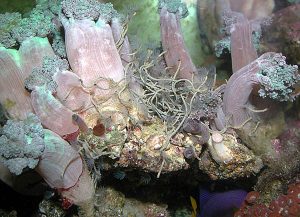
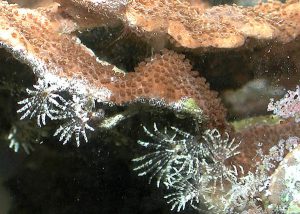
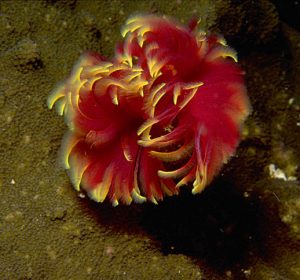
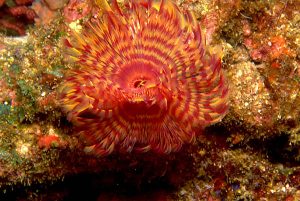
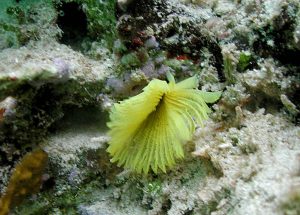




Can you tell me anything about the “Campfire” feather duster? Lifespan? Where are they collected from?
Thanks